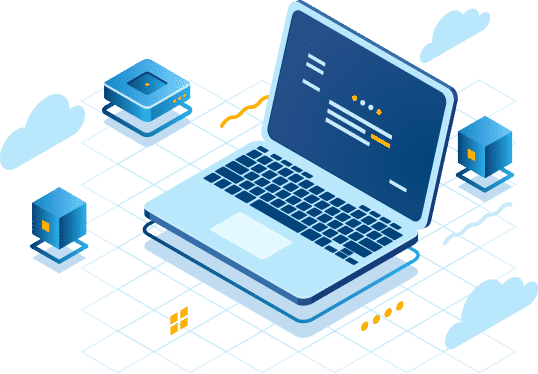Vulnerability Management and Remediation Software
Vulnerability management software with built-in vulnerability remediation
Detect vulnerabilities, automatically patch, or apply compensating controls
Real-time vulnerability assessment and remediation
Free initial vulnerability assessment for unlimited endpoints
OS and application vulnerability patching with no VPN needed
Management and automation of compensating controls
Secure and trusted: SOC 2 Type II, ISO 27001:2022 and GDPR
Enterprise-grade Vulnerability Management and Remediation
Action1 is an automated vulnerability management software for real-time vulnerability detection and vulnerability remediation that includes OS and application vulnerability patching and management of compensating controls. Unlike other vulnerability management tools, Action1 combines vulnerability assessment and remediation into one unified cloud-native vulnerability management solution. This enables a consistent vulnerability management process which includes scanning for vulnerabilities, prioritization of CVEs, remediation of prioritized vulnerabilities via automated patch management, or applying compensating controls when patching is not possible.
Remediate OS vulnerabilities
Detect Windows OS vulnerabilities across all workstations and servers, in corporate networks or remote, VPN-free locations.
Remediate third-party vulnerabilities
Automatically detect vulnerabilities in installed software applications and remediate them by deploying patches tested by Action1 team shortly after they become available.
Real-time vulnerability assessment
See in seconds what OS and applications are vulnerable on what machines, either by an endpoint or by a CVE number.
What is Vulnerability Management?
Vulnerability management is the process of detecting, prioritizing and remediating software vulnerabilities, which includes vulnerability scanning, patching (deployment of OS and software updates), and applying compensating controls. Implementing a vulnerability management solution helps to address security vulnerabilities in operating systems and third-party applications before they are exploited by threat actors. Action1 vulnerability management tool enables real-time vulnerability assessment, prioritization, automated patch management, implementation of compensating control, as well as vulnerability management status reporting.
Automate vulnerability management
Choose remediation schedule for update deployment to meet your vulnerability management policy requirements and SLAs, distinguishing between critical and non-critical remediations.
Prioritize vulnerability remediation
Quickly spot most critical vulnerabilities in your entire environment, define vulnerability remediation SLAs, enforce vulnerability remediation compliance.
Apply compensating controls
When patches are not available or not feasible, automate deployment and documentation of compensating controls to mitigate unpatched vulnerabilities.
Why customers use Action1 for vulnerability management
Remediate vulns without VPN
Patch everything with Action1 cloud-native platform. No company network or VPN connection required.
Value in minutes, not hours or days
Start getting value in minutes, not hours or days. Detect and remediate vulnerabilities consistently without legacy technology, clunky integrations, or multiple consoles.
Avoid bandwidth issues
Remediate vulnerabilities faster and ensure network availability for critical applications with Action1’s P2P patch distribution capability.
Secure and trusted
Action1 is the only integrated vulnerability remediation solution with both SOC 2 Type II and ISO 27001:2022 certifications.
Remediate vulnerabilities offline
Improve your vulnerability remediation rates by automatically deploying OS and third-party patches, as soon as offline endpoints come back online.
See phenomenal ROI
See #1 cloud-native patch management in action
Frequently Asked Questions
What is Vulnerability Management Software?
Vulnerability Management Software is a tool designed to identify, classify, and address security vulnerabilities within an organization’s IT infrastructure. It automates the process of scanning systems, applications, and networks for potential security weaknesses. This software then provides detailed reports, outlining the risks and recommending mitigation strategies.
Key features typically include continuous monitoring, automatic scanning, and integration with patch management systems. By doing so, it helps organizations to proactively manage potential security threats before they can be exploited by attackers.
How does Vulnerability Management Software work?
Vulnerability Management Software works by conducting regular scans of an organization’s IT environment to detect potential security issues. It typically uses databases of known vulnerabilities, such as the CVE (Common Vulnerabilities and Exposures) system, to compare with the infrastructure it is scanning. When a vulnerability is detected, the software assigns a risk level, categorizes the issue, and suggests corrective actions.
The software may use techniques like network scanning, configuration reviews, and software assessments. Continuous monitoring ensures that new vulnerabilities are flagged as they emerge. The results of these scans are compiled into reports that IT teams can use to prioritize and address vulnerabilities based on severity and impact.
Why is Vulnerability Management Software important for cybersecurity?
Vulnerability Management Software is crucial for cybersecurity because it helps organizations stay ahead of potential security breaches. Cyber threats are constantly evolving, and new vulnerabilities are discovered regularly. Without proper tools, it becomes challenging for IT teams to keep up with the identification and resolution of these weaknesses.
By continuously scanning and reporting vulnerabilities, the software helps reduce the attack surface, making it harder for malicious actors to exploit security flaws. It also ensures compliance with industry regulations and standards, which often require regular vulnerability assessments.
What are the key benefits of using Vulnerability Management Software?
The key benefits of using Vulnerability Management Software include improved security posture, time savings, and better resource management. First, it enhances an organization’s overall security by identifying vulnerabilities that could lead to breaches or data loss. Second, automated scanning and reporting save time for IT teams, allowing them to focus on remediation rather than manual vulnerability checks. Third, it allows organizations to prioritize vulnerabilities based on risk, ensuring that critical issues are addressed first.
Additionally, using such software can improve regulatory compliance, providing documented evidence of security efforts. Many solutions offer integrations with other security tools like patch management, making the vulnerability resolution process more seamless.
How can organizations choose the right Vulnerability Management Software?
Choosing the right Vulnerability Management Software requires organizations to consider several factors. First, the software should be scalable, capable of handling the size and complexity of the organization’s IT infrastructure. It should also offer comprehensive coverage, scanning across different environments, including cloud, on-premises, and hybrid systems.
Another important factor is ease of use, particularly the software’s reporting and dashboard capabilities, which should be clear and actionable. Finally, the solution should integrate well with existing security tools, such as SIEM (Security Information and Event Management) systems, patch management solutions, and configuration management databases.






